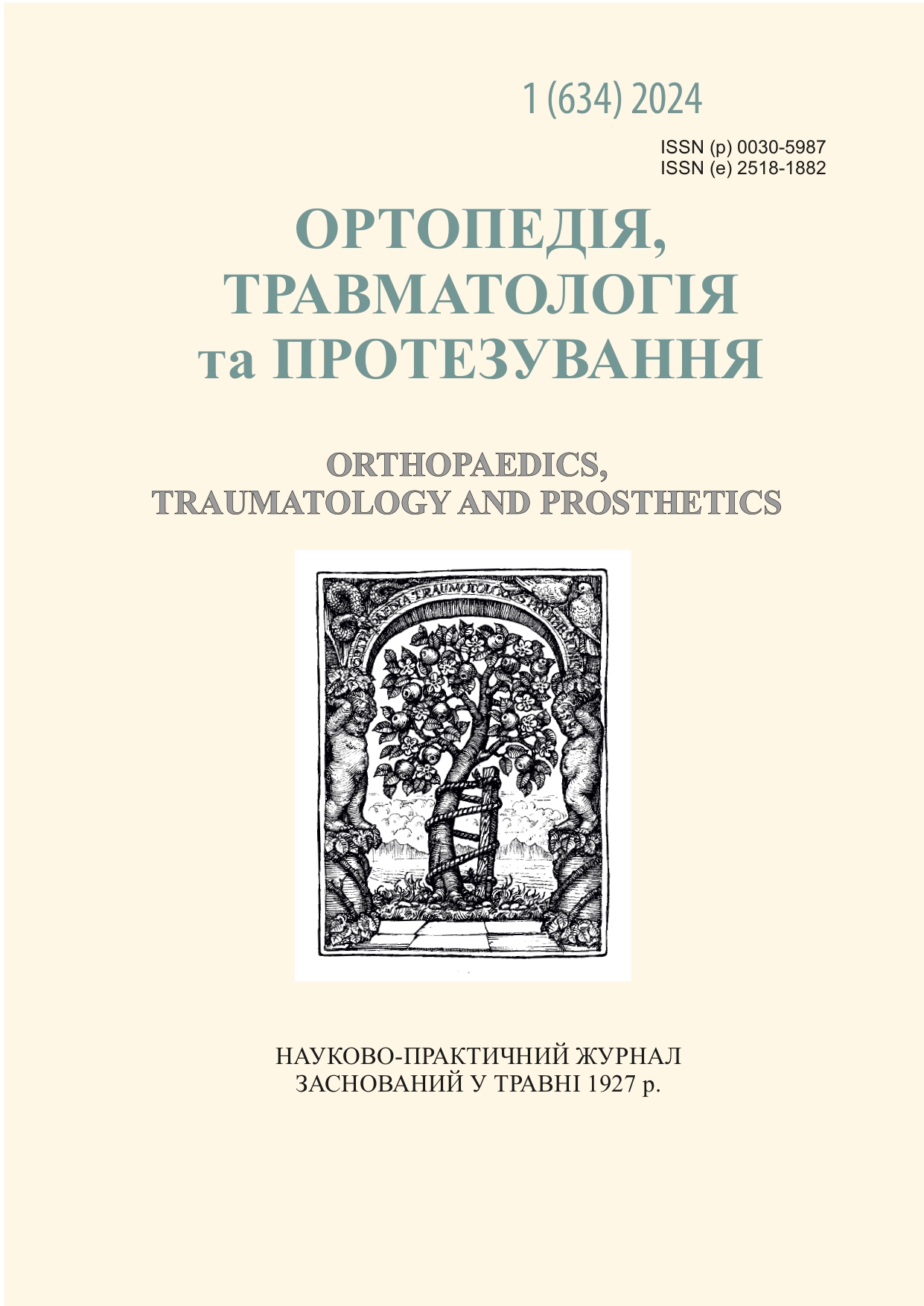USING THE PIPKIN CLASSIFICATION IN DETERMINING THE TREATMENT TACTICS OF FEMORAL HEAD FRACTURES
DOI:
https://doi.org/10.15674/0030-59872024127-32Keywords:
Fracture of the femoral head, dislocation of the hip, hip joint, osteosynthesis, endoprostheticsAbstract
Femoral head fractures are a rare injury with limited information in the literature. Recent studies have been based on small case series, indicating that the incidence of fractures in hip dislocation varies from 7 to 18 %. Fractures of the femoral head are classified according to Pipkin. Treatment is often accompanied by significant complications, and the choice of the optimal treatment method remains a matter of debate. The choice of treatment tactics affects the duration of treatment and functional outcome. The article presents the results of treatment of patients whose treatment tactics were based on the Pipkin classification. Objective. To substantiate the use of the Pipkin classification of femoral head fractures in the selection of treatment and diagnostic tactics. Methods. The study was performed by evaluating the results of treatment in 44 patients. The Pipkin classification was used to determine the treatment tactics. The results were evaluated according to the HHS scale. The results were statistically analysed by comparing the median scores for different groups using the Mann-Whitney U test. Results. The worst prognosis was for patients with Pipkin III and Pipkin IV fractures. HHS scores for patients with complicated outcomes are worse than for patients with uncomplicated outcomes. Treatment outcomes for Pipkin type III fractures are statistically significantly lower than for other types. Conclusions. Pipkin fractures are a rare and severe injury that can cause significant limb dysfunction with proper treatment. Treatment of Pipkin type I and type II includes immediate reduction of the dislocation and conservative treatment in case of satisfactory fragmentation or open reduction with metal osteosynthesis for displaced fractures; for type III and IV, open reduction and osteosynthesis are possible for young patients, and primary arthroplasty is recommended for patients over 60 years of age or with concomitant metabolic diseases.
References
- Birkett, J. (2000). Description of a Dislocation of the Head of the Femur, Complicated With its Fracture. With Remarks: Clinical Orthopaedics and Related Research, 377, 4–6. https://doi.org/10.1097/00003086-200008000-00002
- Bettinelli, G., Placella, G., Moharamzadeh, D., Belluati, A., & Salini, V. (2021). Articular Femoral Head Fracture Management: A Meta-analysis of Literature. Indian Journal of Orthopaedics, 55(S2), 304–313. https://doi.org/10.1007/s43465-021-00431-4
- Braun, B. J., Holstein, J. H., & Pohlemann, T. (2019). Pipkin Fractures. В L. Büchler & M. J. B. Keel (Ed.), Fractures of the Hip (pp. 123–137). Springer International Publishing. https://doi.org/10.1007/978-3-030-18838-2_11
- Enocson, A., & Wolf, O. (2022). Pipkin fractures: Epidemiology and outcome. European Journal of Trauma and Emergency Surgery, 48(5), 4113–4118. https://doi.org/10.1007/s00068-022-01951-w
- Pipkin, G. (1957). Treatment of Grade IV Fracture-Dislocation of the Hip: A REVIEW. JBJS, 39(5), 1027.
- Goulet, J. A., & Levin, P. E. (2003). Hip dislocations. In: Skeletal trauma: basic science, management, and reconstruction
- (рр.1657–1669). Philadelphia: Saunders.
- Engel, J. L., Johnsen, P., Patel, N. K., Satpathy, J., & Mounasamy, V. (2021). Pipkin type IV femoral head fractures: A case series and review of literature. European Journal of Orthopaedic Surgery & Traumatology, 31(4), 791–795. https://doi.org/10.1007/s00590-020-02838-5
- Zhao, B., Li, H., Yan, J., Han, L.-R., & Yang, X.-F. (2017). Pipkin type III femoral head fracture–dislocation combined with complicated acetabular fracture. Medicine, 96(50), e9214. https://doi.org/10.1097/MD.0000000000009214
- Wang, J., Cai, L., Xie, L., Chen, H., Guo, X., & Yu, K. (2019). 3D printing-based Ganz approach for treatment of femoral head fractures: A prospective analysis. Journal of Orthopaedic Surgery and Research, 14(1), 338. https://doi.org/10.1186/s13018-019-1383-7
- Mahomed, N. N., Arndt, D. C., McGrory, B. J., & Harris, W. H. (2001). The Harris hip score: Comparison of patient self-report with surgeon assessment. The Journal of Arthroplasty, 16(5), 575–580. https://doi.org/10.1054/arth.2001.23716
- Wang, S., Yu, X., Li, B., Ding, Q., Wang, T., Li, Q., Liu, L., & Wu, H. (2023). Pipkin type III femoral head fracture: Which treatment strategy can be recommended? Journal of Orthopaedics and Traumatology, 24(1), 28. https://doi.org/10.1186/s10195-023-00701-x
- Dong, D., Li, Y., Zhu, D., Yu, M., & Gu, G. (2020). Comparison of Fragment Removal Versus Internal Fixation for Treatment of Pipkin I Femoral Head Fractures: A Finite Element Analysis. International Surgery, 104(5–6), 262–268. https://doi.org/10.9738/INTSURG-D-16-00039R1
Downloads
How to Cite
Issue
Section
License

This work is licensed under a Creative Commons Attribution 4.0 International License.
The authors retain the right of authorship of their manuscript and pass the journal the right of the first publication of this article, which automatically become available from the date of publication under the terms of Creative Commons Attribution License, which allows others to freely distribute the published manuscript with mandatory linking to authors of the original research and the first publication of this one in this journal.
Authors have the right to enter into a separate supplemental agreement on the additional non-exclusive distribution of manuscript in the form in which it was published by the journal (i.e. to put work in electronic storage of an institution or publish as a part of the book) while maintaining the reference to the first publication of the manuscript in this journal.
The editorial policy of the journal allows authors and encourages manuscript accommodation online (i.e. in storage of an institution or on the personal websites) as before submission of the manuscript to the editorial office, and during its editorial processing because it contributes to productive scientific discussion and positively affects the efficiency and dynamics of the published manuscript citation (see The Effect of Open Access).














